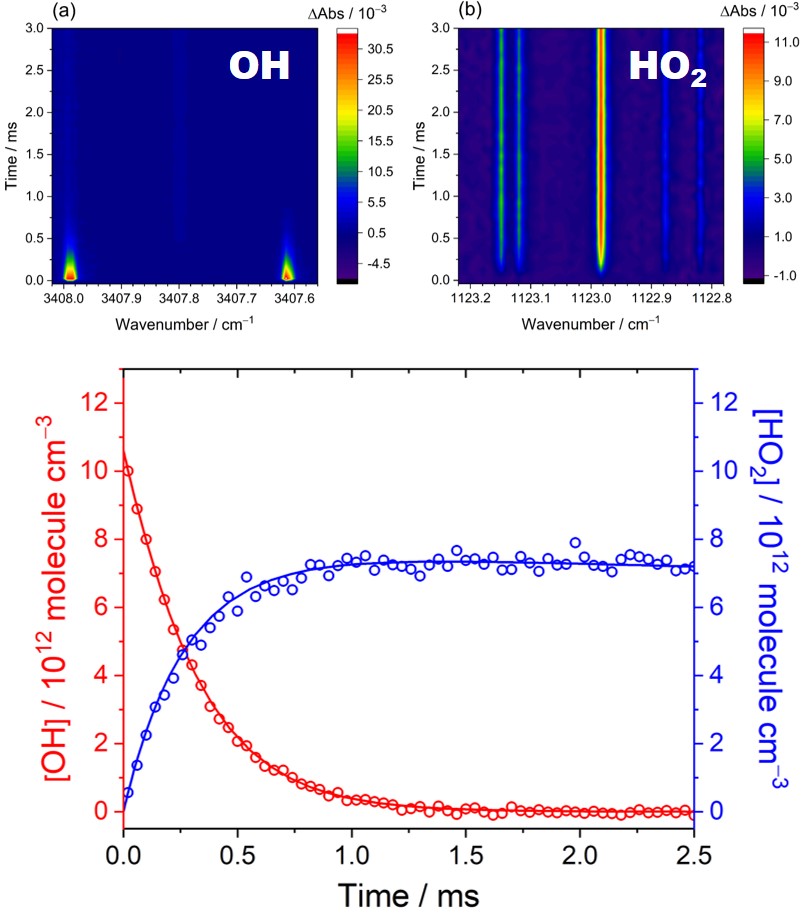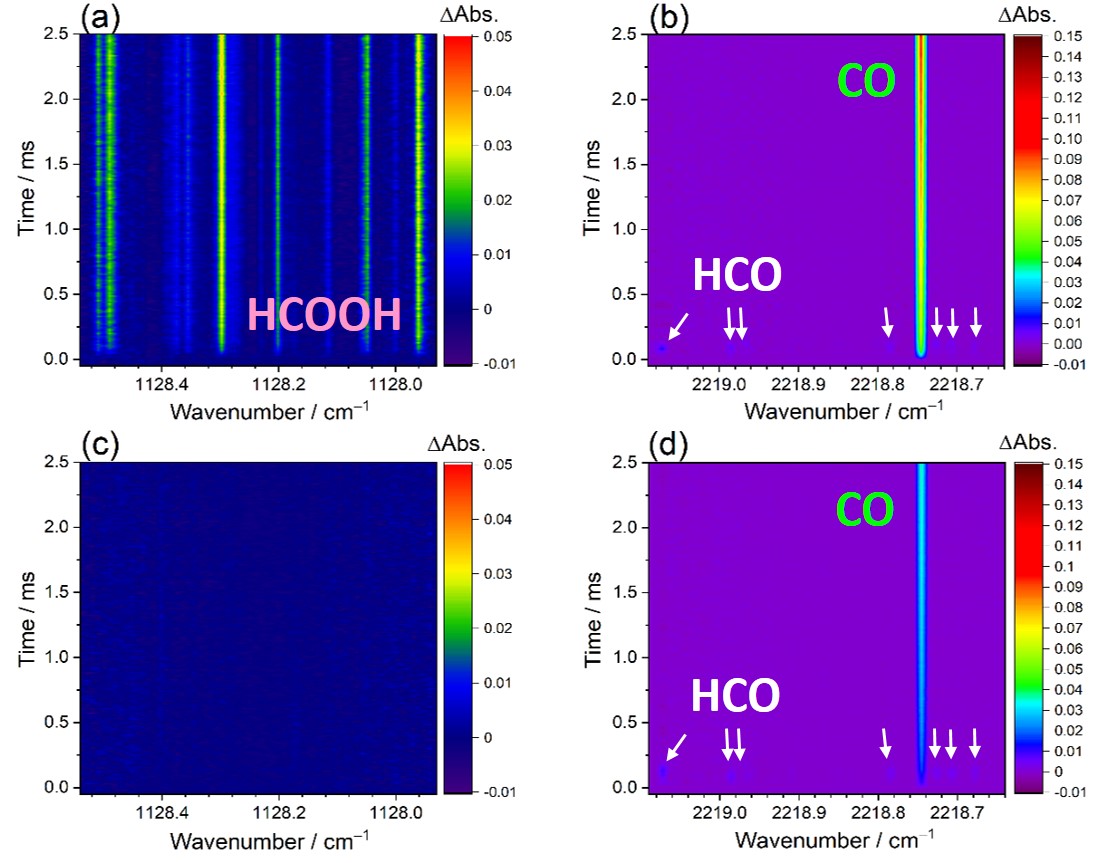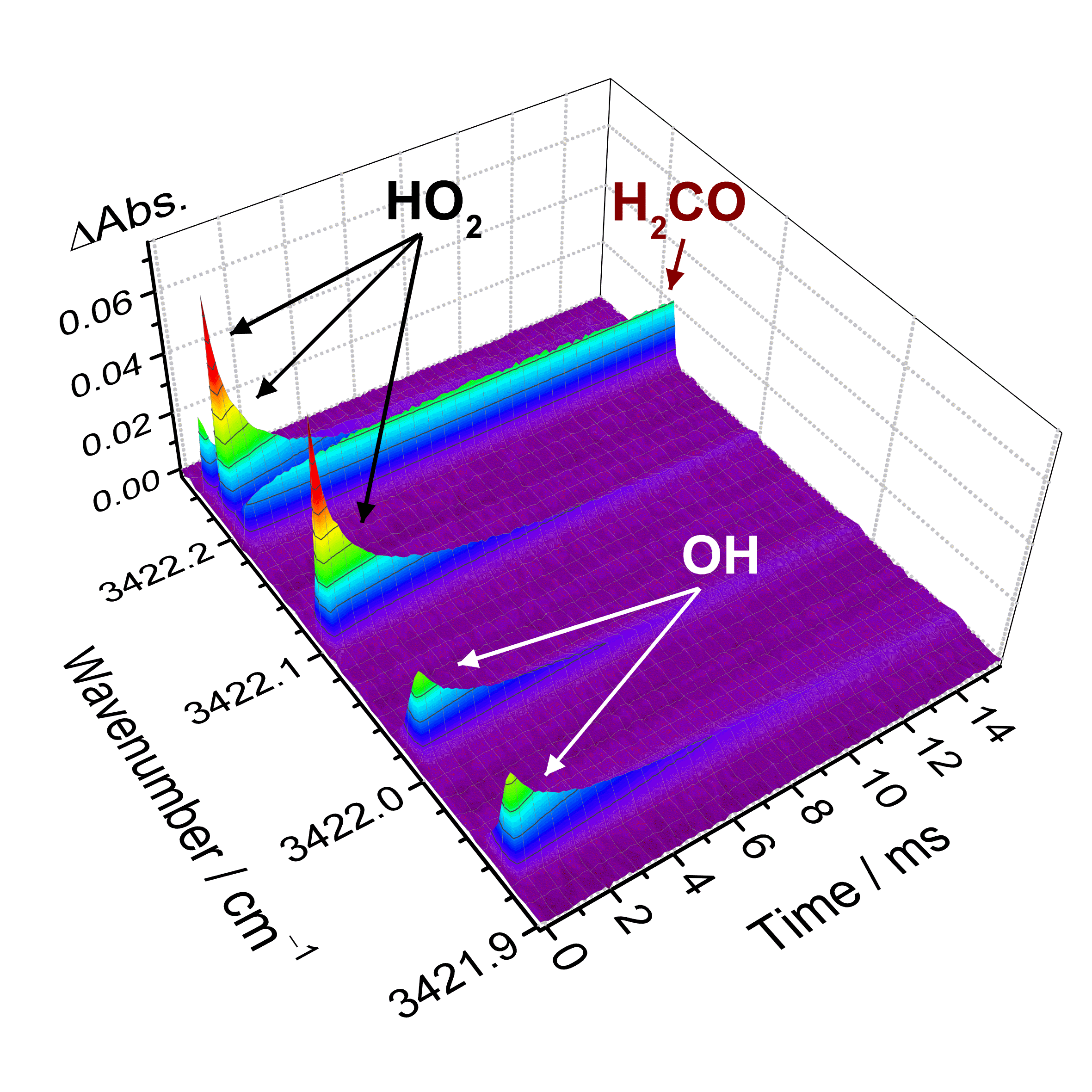I-Yun Chen, Che-Wei Chang, Christa Fittschen, and Pei-Ling Luo*
J. Phys. Chem. Lett.,15, 3733–3739 (2024)

The radical–radical reaction between OH and HO2 has been considered for a long time as an important reaction in tropospheric photochemistry and combustion chemistry. However, a significant discrepancy of an order of magnitude for rate coefficients of this reaction is found between two recent experiments. Herein, we investigate the reaction OH + HO2 via direct spectral quantification of both the precursor (H2O2) and free radicals (OH and HO2) upon the 248 nm photolysis of H2O2 using infrared two-color time-resolved dual-comb spectroscopy. With quantitative and kinetic analysis of concentration profiles of both OH and HO2 at varied conditions, the rate coefficient kOH+HO2 is determined to be (1.10 ± 0.12) × 10–10 cm3 molecule–1 s–1 at 296 K. Moreover, we explore the kinetics of this reaction under conditions in the presence of water, but no enhancement in the kOH+HO2 can be observed. This work as an independent experiment plays a crucial role in revisiting this prototypical radical–radical reaction.
Pei-Ling Luo*, I-Yun Chen, M. Anwar H. Khan, and Dudley E. Shallcross
Communications Chemistry, 6, 130 (2023)

Ozonolysis of isoprene is considered to be an important source of formic acid (HCOOH), but its underlying reaction mechanisms related to HCOOH formation are poorly understood. Here, we report the kinetic and product studies of the reaction between the simplest Criegee intermediate (CH2OO) and formaldehyde (HCHO), both of which are the primary products formed in ozonolysis of isoprene. By utilizing time-resolved infrared laser spectrometry with the multifunctional dual-comb spectrometers, the rate coefficient kCH2OO+HCHO is determined to be (4.11 ± 0.25) × 10−12 cm3 molecule−1 s−1 at 296 K and a negative temperature dependence of the rate coefficient is observed and described by an Arrhenius expression with an activation energy of (–1.81 ± 0.04) kcal mol−1. Moreover, the branching ratios of the reaction products HCOOH + HCHO and CO + H2O + HCHO are explored. The yield of HCOOH is obtained to be 37–54% over the pressure (15–60 Torr) and temperature (283–313 K) ranges. The atmospheric implications of the reaction CH2OO + HCHO are also evaluated by incorporating these results into a global chemistry-transport model. In the upper troposphere, the percent loss of CH2OO by HCHO is found by up to 6% which can subsequently increase HCOOH mixing ratios by up to 2% during December-January-February months.
Pei-Ling Luo* and I-Yun Chen
Analytical Chemistry, 94, 5752 (2022).

A novel spectrometer has been developed based on synchronized two-color time-resolved dual-comb spectroscopy (TRDCS), enabling high-resolution hyperspectral measurements. The proposed approach with TRDCS exhibits great potential in quantitative diagnostics of multispecies and opens opportunities to decipher key reaction mechanisms in atmospheric chemistry. In this work, we perform simultaneous measurements in two distinct molecular fingerprint regions near 2.9 and 7.8 μm by employing the new approach with synchronized two-color TRDCS. Upon flash photolysis of CH2I2/O2/N2 gas mixtures, multiple reaction species, involving the simplest Criegee intermediates (CH2OO), formaldehyde (CH2O), hydroxyl (OH) and hydroperoxy (HO2) radicals are simultaneously detected with microsecond time resolution. The concentration of each molecule can be determined based on high-resolution rovibrational absorption spectroscopy. With quantitative detection and simulation of temporal concentration profiles of the targeted molecules at various conditions, the underlying reaction mechanisms and pathways related to the formation of the HOx radicals, which can be generated from decomposition of initially energized and vibrationally excited Criegee intermediates, are explored.
Pei-Ling Luo* & Er-Chien Horng
Communications Chemistry, 3, 95 (2020)

Quantitative determination of multiple transient species is critical in investigating reaction mechanisms and kinetics under various conditions. Dual-comb spectroscopy, a comb-laser-based multi-heterodyne interferometric technique that enables simultaneous achievement of broadband, high-resolution, and rapid spectral acquisition, opens a new era of time-resolved spectroscopic measurements. Employing an electro-optic dual-comb spectrometer with central wavelength near 3 µm coupled with a Herriott multipass absorption cell, here we demonstrate simultaneous determination of multiple species, including methanol, formaldehyde, HO2 and OH radicals, and investigate the reaction kinetics. In addition to quantitative spectral analyses of high-resolution and tens of microsecond time-resolved spectra recorded upon flash photolysis of precursor mixtures, we determine a rate coefficient of the HO2 + NO reaction by directly detecting both HO2 and OH radicals. Our approach exhibits potential in discovering reactive intermediates and exploring complex reaction mechanisms, especially those of radical-radical reactions.
